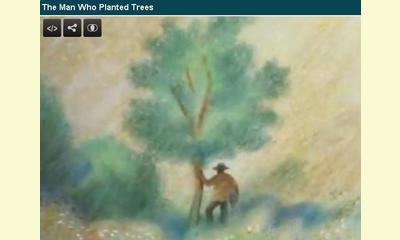|
|
Frédéric Back, Director of "The Man Who Planted Trees"
un articulo por Janet Hudgins
Video: The Man Who Planted Trees
Frédéric Back recently died after a lifetime of
producing art and animated films, the most
recognized of which is “The Man Who Planted
Trees." The film won him two Academy Awards. He
was an eco-artist, his love of nature and his
creative talent making him celebrated in his
animation and paintings, copies of which are still
available online and in libraries. See the Cartoon Brew website.

A frame from the film, The Man Who Planted Trees
click on photo to enlarge
Back was born in Germany, emigrated to Montreal in
1948, began his career as a graphic artist in
Radio Canada (first television) and teaching art
at Ecole des Beaux-Arts de Montreal. In the 1970s
and 80s he produced many films, was nominated and
won awards, the Order of Canada among them, and
his animation became famous. It is still studied
in art schools “for their technical, artistic and
cultural content,” Back wrote on his website.
“That goes beyond anything I might have hoped for
and still surprises me. It shows that politically
engaged art is both possible and worthwhile.”
I have loved “The Man Who Planted Trees” for 30
years and never tire of seeing it again. Taken
from a story by the French short story writer,
Jean Giano, the hand-drawn 30-minute animation
tells the tale of a shepherd who sees a barren
valley and restores it with thousands of trees.
Canadian actor Christopher Plummer narrates the
English version and it was produced by Radio
Canada.
Among Back’s other acclaimed shorts were the Oscar-
nominated Tout Rien (1980) and The Mighty River (Le
Fleuve aux Grandes Eaux) (1994) and the Oscar-
winning Crac, which looked at the industrialization
of Montreal from the perspective of a rocking chair.
|








|
DISCUSSION
Pregunta(s) relacionada(s) al artículo :
Do the arts create a basis for a culture of peace?, What is, or should be, their role in our movement?
* * * * *
Comentario más reciente:
:
Yes, the arts do create a basis for a culture of peace.
The question I would raise is where are the visual artists who have produced a Guernica like painting of Felluja? Paintings last longer than photographs which are too often fleeting.
Do the poets against the war meet annually?
I caught a bit of an interesting tv show which featured world class artists such as Wole Soyinka speaking in Israel/Palestine about ways to further the peace movement there. Did anyone else see the entire show?
I hope a local Peace Day could emulate the UN opening ceremony .

|
|









